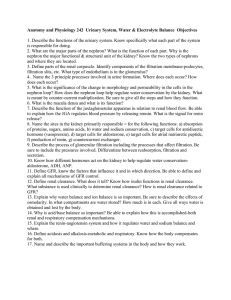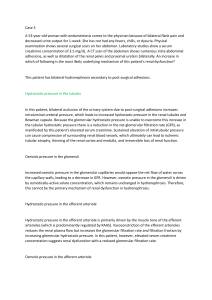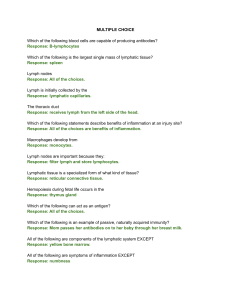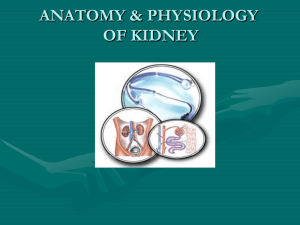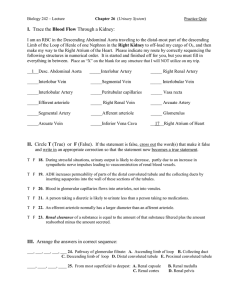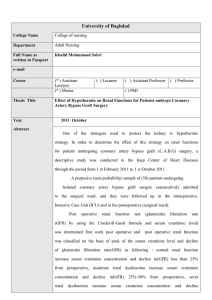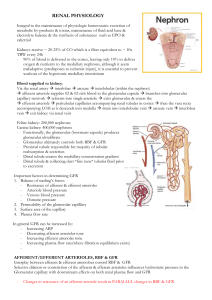question
advertisement
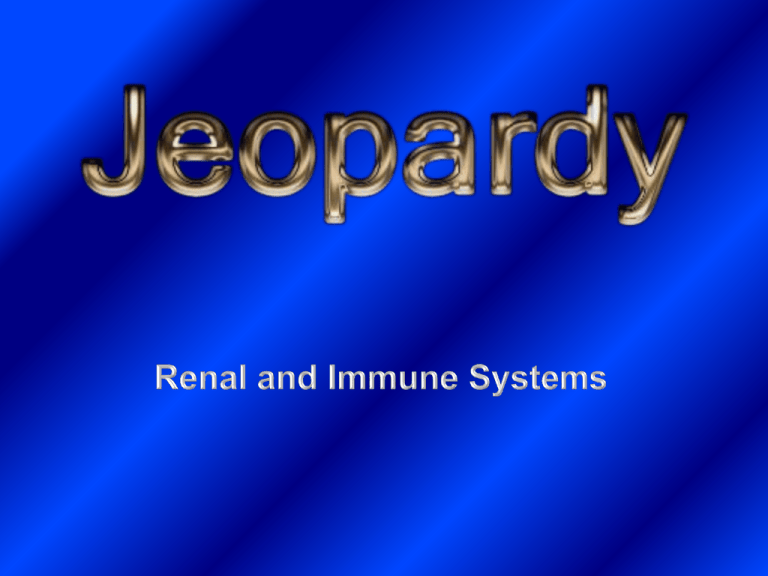
Renal 1 Renal 2 Misc. Immune 1 Immune 2 10 10 10 10 10 20 20 20 20 20 30 30 30 30 30 40 40 40 40 40 50 50 50 50 50 QUESTION: •What is the functional unit of the kidney? ANSWER: •Nephron QUESTION: •Name two types of nephrons. ANSWER: •Cortical •Juxtamedullary QUESTION: •What are the three protective layers surrounding the kidney? ANSWER: •Renal fascia •Perirenal fat capsule •Fibrous capsule QUESTION: •Name the parts of the renal tubule. ANSWER: •PCT •Descending LOH •Ascending LOH •DCT •Collecting ducts QUESTION: •Trace the blood flow through the nephron. ANSWER: • • • • • Afferent arteriole Glomerulus Efferent arteriole Peritubular capillaries Vasa recta QUESTION: •What do the cells in the PCT look like? ANSWER: •Microvilli •Mitochondria QUESTION: •What is the function of the DCT? ANSWER: •Secretion QUESTION: •What is the function of intercalated cells and principal cells? ANSWER: •Intercalated – Maintain acid-base balance •Principal – Water and salt regulation QUESTION: •Describe how the myogenic mechanism works. ANSWER: • When blood pressure goes up, afferent arterioles constrict to slow down GFR •When blood pressure goes down, afferent arterioles dilate to speed up GFR QUESTION: •What are the three stages of urine formation? ANSWER: •Glomerular filtration •Tubular reabsorption •Tubular secretion QUESTION: •What is the defining characteristic of NK cells? ANSWER: •Not phagocytic QUESTION: •Name the three layers of the filtration membrane. ANSWER: •Capillary endothelium •Basement membrane •Podocyte QUESTION: •Name three hormones in the renal system and what they do. ANSWER: •Parathyroid hormone – regulates calcium levels •ADH – water regulation •Aldosterone – sodium regulation QUESTION: •What are the four stages of phagocyte mobilization? ANSWER: •Leukocytosis •Margination •Diapedesis •Chemotaxis QUESTION: •Describe how the tubuloglomerular feedback mechanism works. ANSWER: •When salt levels are high, macula densa cells of JGA release vasoconstricting chemical •Afferent arteriole constricts, GFR decreases QUESTION: •Name two barriers in the first line of defense. ANSWER: •Skin •Mucous membranes QUESTION: •Name two cell types that are a part of the second line of defense. ANSWER: •Macrophages •Neutrophils •Natural killer cells •Phagocytes QUESTION: •What are two signs of the inflammatory response? ANSWER: •Swelling •Redness •Heat •Pain QUESTION: •Name two characteristics of the adaptive immune system. ANSWER: •Antigen specific •Systemic •Has memory QUESTION: •What does SCID and AIDS stand for? ANSWER: •Severe combined immunodeficiency •Acquired immunodeficiency syndrome QUESTION: •Where do T-cells and B-cells mature? ANSWER: •Thymus •Bone marrow QUESTION: •How can an organism acquire immunity actively? ANSWER: •Having an infection •Vaccinations QUESTION: •What is one type of passive immunity? ANSWER: •Donor antibodies •Mother’s antibodies QUESTION: •What type of protein recognizes normal cells as “self?” ANSWER: •Class I major histocompatibility complex proteins (MHC) QUESTION: •What is one autoimmune disease? ANSWER: •Rheumatoid arthritis •Multiple sclerosis

